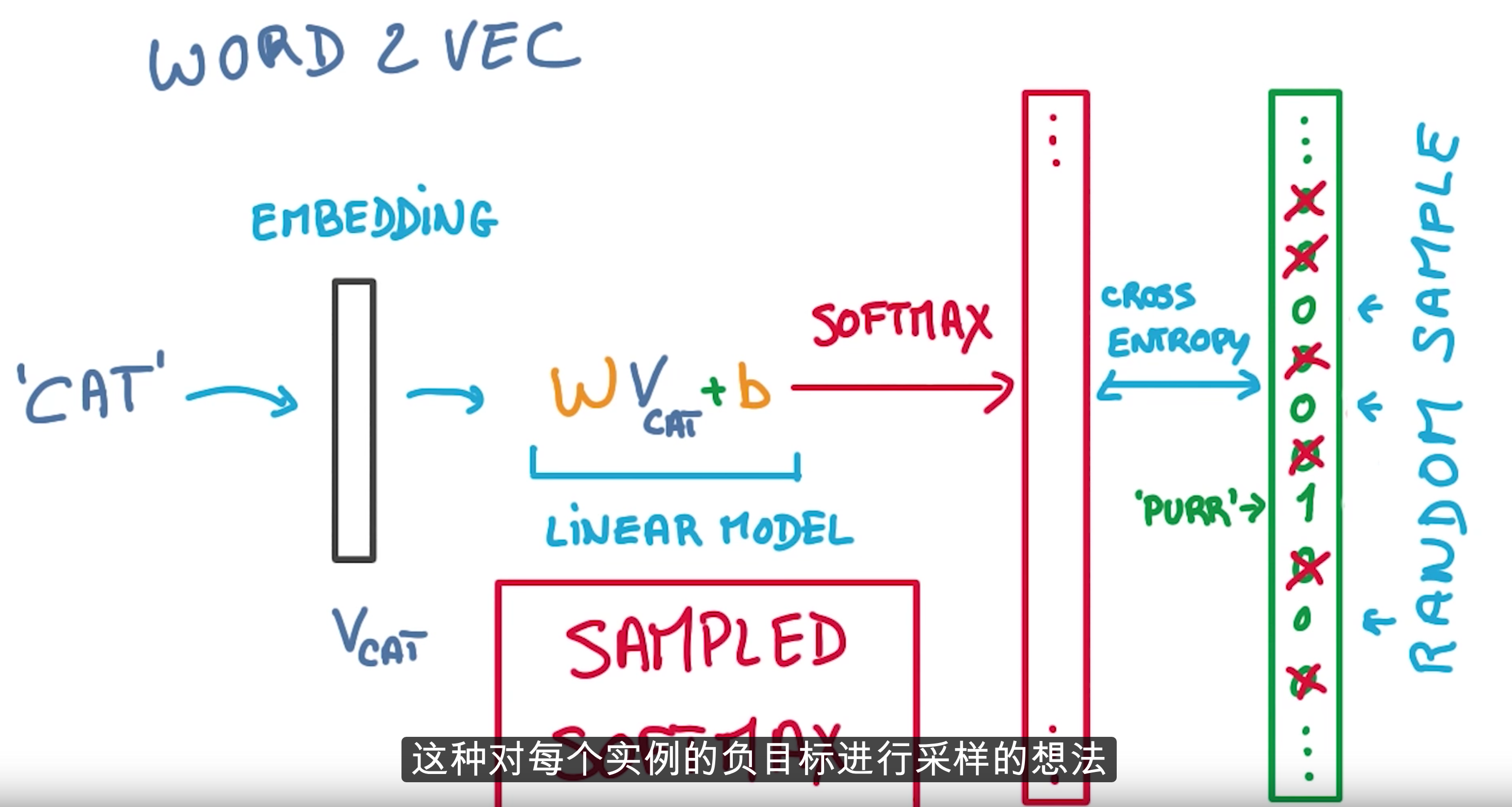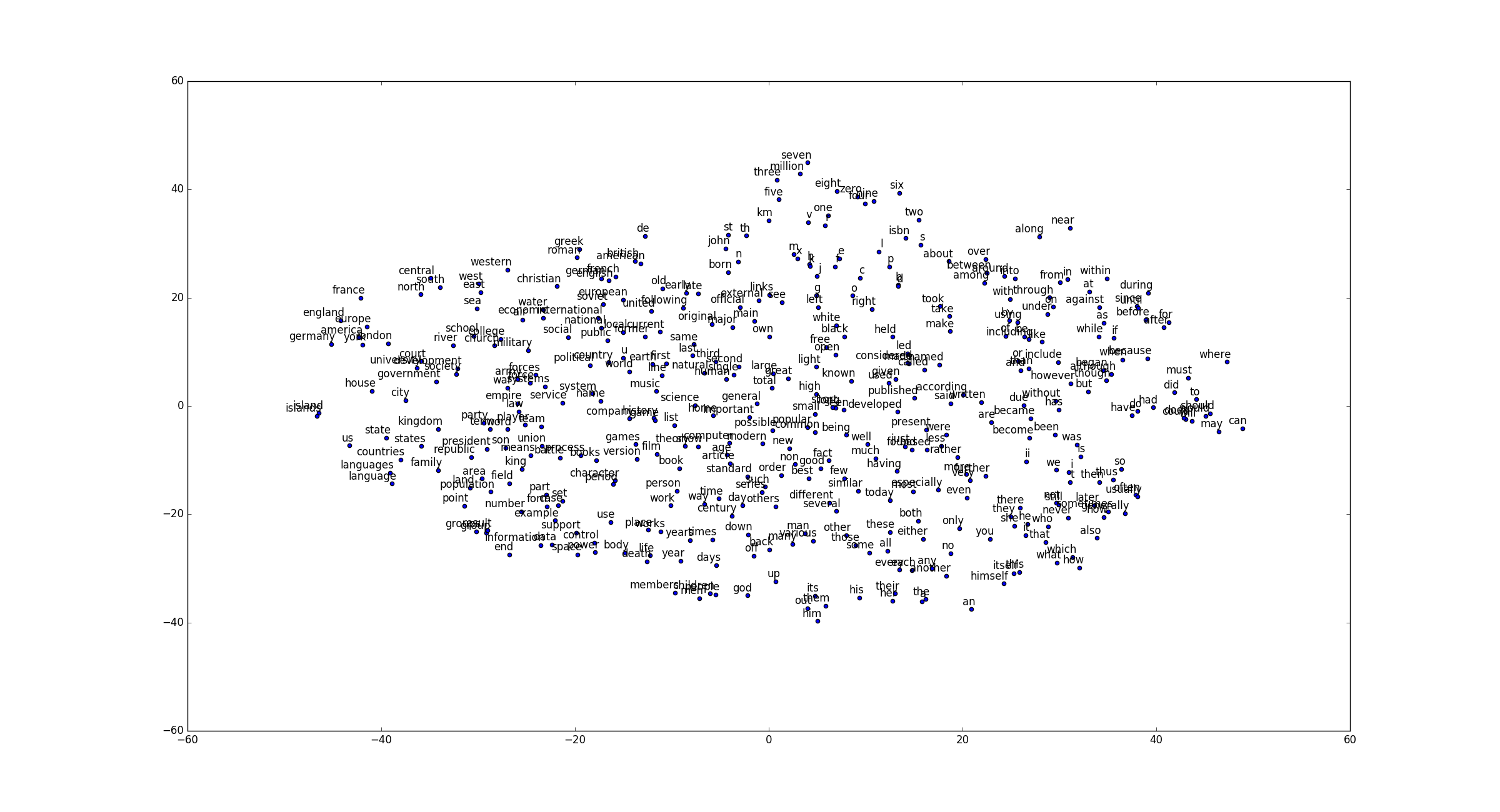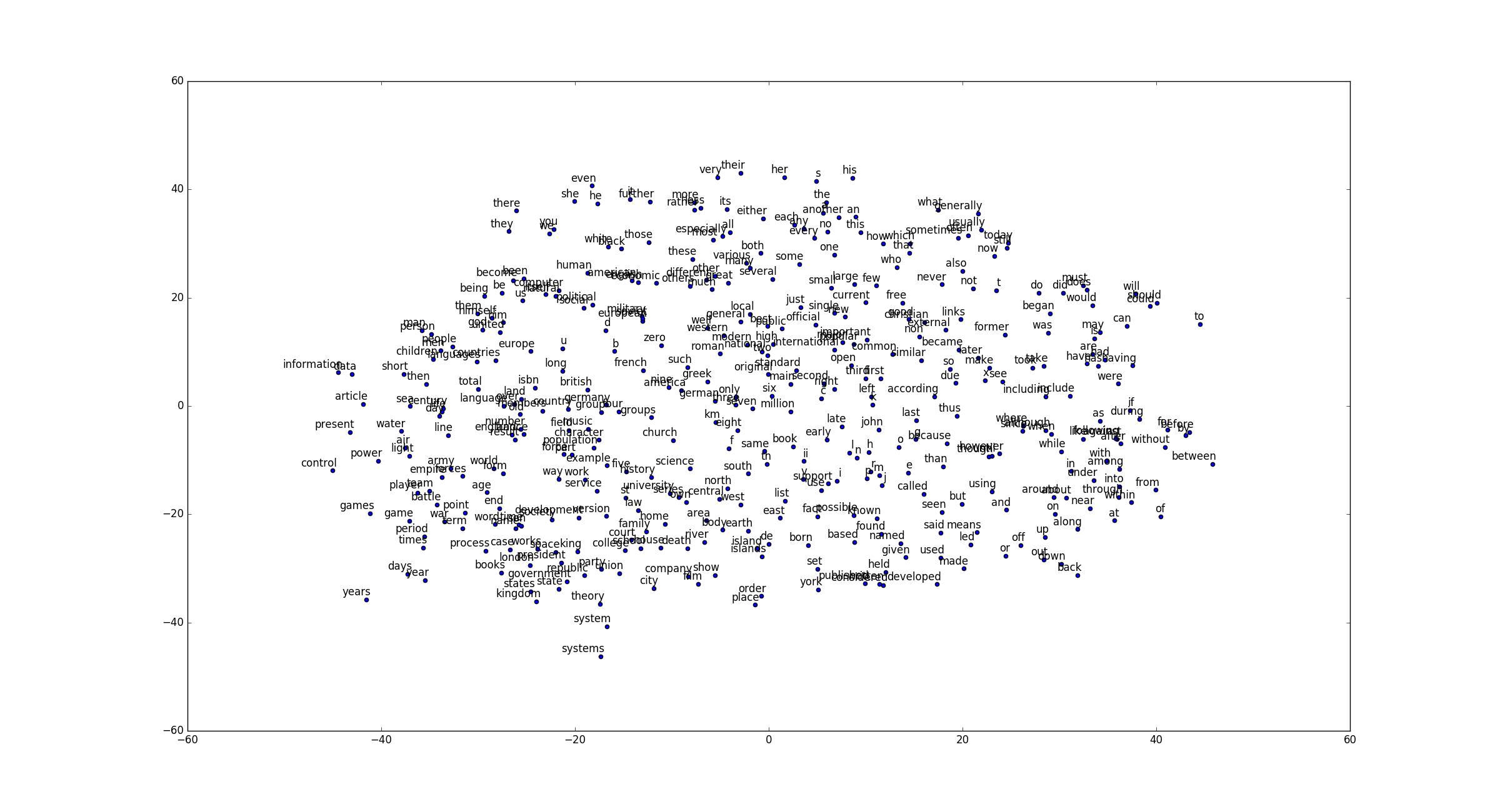课上讲的太简略了,原理参考《word2vec原理推导与代码分析》。谷歌给的代码也很简陋,只有负采样,没有哈夫曼树。另外单机word2vec已经那么高效了,我质疑上TF的意义。

任务 5: Word2Vec&CBOW
这次的任务是在text8语料上训练Word2Vec skip-gram和CBOW模型,其中skip-gram训练代码已经给出,请实现CBOW的训练。
总之先把谷歌给的skip-gram代码先看一遍吧,与《word2vec原理推导与代码分析》不同,这次的实现明显规模小很多,只计算前50000个高频词:
vocabulary_size = 50000
def build_dataset(words):
count = [['UNK', -1]]
count.extend(collections.Counter(words).most_common(vocabulary_size - 1))
dictionary = dict()
for word, _ in count:
dictionary[word] = len(dictionary)
data = list()
unk_count = 0
for word in words:
if word in dictionary:
index = dictionary[word]
else:
index = 0 # dictionary['UNK']
unk_count = unk_count + 1
data.append(index)
count[0][1] = unk_count
reverse_dictionary = dict(zip(dictionary.values(), dictionary.keys()))
return data, count, dictionary, reverse_dictionary
data, count, dictionary, reverse_dictionary = build_dataset(words)
print('Most common words (+UNK)', count[:5])
print('Sample data', data[:10])
del words # Hint to reduce memory.
输出
Most common words (+UNK) [['UNK', 418391], ('the', 1061396), ('of', 593677), ('and', 416629), ('one', 411764)]
Sample data [5236, 3084, 12, 6, 195, 2, 3134, 46, 59, 156]
data: ['anarchism', 'originated', 'as', 'a', 'term', 'of', 'abuse', 'first']
dictionary是词到id的映射。
接下来生成skip-gram训练实例:
data_index = 0
def generate_batch(batch_size, num_skips, skip_window):
global data_index
assert batch_size % num_skips == 0
assert num_skips <= 2 * skip_window
batch = np.ndarray(shape=(batch_size), dtype=np.int32)
labels = np.ndarray(shape=(batch_size, 1), dtype=np.int32)
span = 2 * skip_window + 1 # [ skip_window target skip_window ]
buffer = collections.deque(maxlen=span)
for _ in range(span):
buffer.append(data[data_index])
data_index = (data_index + 1) % len(data)
for i in range(batch_size // num_skips):
target = skip_window # target label at the center of the buffer
targets_to_avoid = [skip_window]
for j in range(num_skips):
while target in targets_to_avoid:
target = random.randint(0, span - 1)
targets_to_avoid.append(target)
batch[i * num_skips + j] = buffer[skip_window]
labels[i * num_skips + j, 0] = buffer[target]
buffer.append(data[data_index])
data_index = (data_index + 1) % len(data)
return batch, labels
print('data:', [reverse_dictionary[di] for di in data[:8]])
for num_skips, skip_window in [(2, 1), (4, 2)]:
data_index = 0
batch, labels = generate_batch(batch_size=8, num_skips=num_skips, skip_window=skip_window)
print('\nwith num_skips = %d and skip_window = %d:' % (num_skips, skip_window))
print(' batch:', [reverse_dictionary[bi] for bi in batch])
print(' labels:', [reverse_dictionary[li] for li in labels.reshape(8)])
输出
with num_skips = 2 and skip_window = 1: batch: ['originated', 'originated', 'as', 'as', 'a', 'a', 'term', 'term'] labels: ['as', 'anarchism', 'originated', 'a', 'term', 'as', 'a', 'of'] with num_skips = 4 and skip_window = 2: batch: ['as', 'as', 'as', 'as', 'a', 'a', 'a', 'a'] labels: ['anarchism', 'term', 'originated', 'a', 'term', 'of', 'as', 'originated']
skip-gram是已知当前词语,预测其上下文。上面这个函数中,窗口大小为2 * skip_window + 1,针对每个窗口中心词语,生成num_skips个训练实例。实例的x是中心词语,y是随机采样的上下文词语(这个采样算法就是平均采样target = random.randint(0, span – 1),根本没有考虑到词频,负分差评),而batch_size控制最终生成多少个训练实例。
机器学习中的分类问题光给正例可不够,还得给负例。这里的负例通过负采样得到:

对应代码中的
num_sampled = 64 # Number of negative examples to sample. # Compute the softmax loss, using a sample of the negative labels each time. loss = tf.reduce_mean( tf.nn.sampled_softmax_loss(softmax_weights, softmax_biases, embed, train_labels, num_sampled, vocabulary_size))
这其实就是softmax逻辑斯谛回归,彻头彻尾的线性模型,一点都不深。
训练就是按照逻辑斯谛回归来,没什么好说的。得到embedding之后使用 t-SNE 可视化数据,据说PCA已经过气了。这一步得到:

题目
替代Skip-gram的另一种语言模型是CBOW,这是已知上下文预测当前词语的模型,请实现它。
生成训练实例
data_index = 0
def generate_batch(batch_size, bag_window):
global data_index
span = 2 * bag_window + 1 # [ bag_window target bag_window ]
batch = np.ndarray(shape=(batch_size, span - 1), dtype=np.int32)
labels = np.ndarray(shape=(batch_size, 1), dtype=np.int32)
buffer = collections.deque(maxlen=span)
for _ in range(span):
buffer.append(data[data_index])
data_index = (data_index + 1) % len(data)
for i in range(batch_size):
# just for testing
buffer_list = list(buffer)
labels[i, 0] = buffer_list.pop(bag_window)
batch[i] = buffer_list
# iterate to the next buffer
buffer.append(data[data_index])
data_index = (data_index + 1) % len(data)
return batch, labels
print('data:', [reverse_dictionary[di] for di in data[:16]])
for bag_window in [1, 2]:
data_index = 0
batch, labels = generate_batch(batch_size=4, bag_window=bag_window)
print('\nwith bag_window = %d:' % (bag_window))
print(' batch:', [[reverse_dictionary[w] for w in bi] for bi in batch])
print(' labels:', [reverse_dictionary[li] for li in labels.reshape(4)])
得到
data: ['anarchism', 'originated', 'as', 'a', 'term', 'of', 'abuse', 'first', 'used', 'against', 'early', 'working', 'class', 'radicals', 'including', 'the'] with bag_window = 1: batch: [['anarchism', 'as'], ['originated', 'a'], ['as', 'term'], ['a', 'of']] labels: ['originated', 'as', 'a', 'term'] with bag_window = 2: batch: [['anarchism', 'originated', 'a', 'term'], ['originated', 'as', 'term', 'of'], ['as', 'a', 'of', 'abuse'], ['a', 'term', 'abuse', 'first']] labels: ['as', 'a', 'term', 'of']
这次的输入x是多个词语(上下文),y依然是单个词语,依然需要负采样。
训练
完整的训练代码
batch_size = 128
embedding_size = 128 # Dimension of the embedding vector.
bag_window = 2 # How many words to consider left and right.
# We pick a random validation set to sample nearest neighbors. here we limit the
# validation samples to the words that have a low numeric ID, which by
# construction are also the most frequent.
valid_size = 16 # Random set of words to evaluate similarity on.
valid_window = 100 # Only pick dev samples in the head of the distribution.
valid_examples = np.array(random.sample(range(valid_window), valid_size))
num_sampled = 64 # Number of negative examples to sample.
graph = tf.Graph()
with graph.as_default(), tf.device('/cpu:0'):
# Input data.
train_dataset = tf.placeholder(tf.int32, shape=[batch_size, bag_window * 2])
train_labels = tf.placeholder(tf.int32, shape=[batch_size, 1])
valid_dataset = tf.constant(valid_examples, dtype=tf.int32)
# Variables.
embeddings = tf.Variable(
tf.random_uniform([vocabulary_size, embedding_size], -1.0, 1.0))
softmax_weights = tf.Variable(
tf.truncated_normal([vocabulary_size, embedding_size],
stddev=1.0 / math.sqrt(embedding_size)))
softmax_biases = tf.Variable(tf.zeros([vocabulary_size]))
# Model.
# Look up embeddings for inputs.
embeds = tf.nn.embedding_lookup(embeddings, train_dataset)
# Compute the softmax loss, using a sample of the negative labels each time.
loss = tf.reduce_mean(
tf.nn.sampled_softmax_loss(softmax_weights, softmax_biases, tf.reduce_sum(embeds, 1),
train_labels, num_sampled, vocabulary_size))
# Optimizer.
optimizer = tf.train.AdagradOptimizer(1.0).minimize(loss)
# Compute the similarity between minibatch examples and all embeddings.
# We use the cosine distance:
norm = tf.sqrt(tf.reduce_sum(tf.square(embeddings), 1, keep_dims=True))
normalized_embeddings = embeddings / norm
valid_embeddings = tf.nn.embedding_lookup(
normalized_embeddings, valid_dataset)
similarity = tf.matmul(valid_embeddings, tf.transpose(normalized_embeddings))
num_steps = 100001
with tf.Session(graph=graph) as session:
tf.initialize_all_variables().run()
print('Initialized')
average_loss = 0
for step in range(num_steps):
batch_data, batch_labels = generate_batch(
batch_size, bag_window)
feed_dict = {train_dataset: batch_data, train_labels: batch_labels}
_, l = session.run([optimizer, loss], feed_dict=feed_dict)
average_loss += l
if step % 2000 == 0:
if step > 0:
average_loss = average_loss / 2000
# The average loss is an estimate of the loss over the last 2000 batches.
print('Average loss at step %d: %f' % (step, average_loss))
average_loss = 0
# note that this is expensive (~20% slowdown if computed every 500 steps)
if step % 10000 == 0:
sim = similarity.eval()
for i in range(valid_size):
valid_word = reverse_dictionary[valid_examples[i]]
top_k = 8 # number of nearest neighbors
nearest = (-sim[i, :]).argsort()[1:top_k + 1]
log = 'Nearest to %s:' % valid_word
for k in range(top_k):
close_word = reverse_dictionary[nearest[k]]
log = '%s %s,' % (log, close_word)
print(log)
final_embeddings = normalized_embeddings.eval()
num_points = 400
tsne = TSNE(perplexity=30, n_components=2, init='pca', n_iter=5000)
two_d_embeddings = tsne.fit_transform(final_embeddings[1:num_points + 1, :])
def plot(embeddings, labels):
assert embeddings.shape[0] >= len(labels), 'More labels than embeddings'
pylab.figure(figsize=(15, 15)) # in inches
for i, label in enumerate(labels):
x, y = embeddings[i, :]
pylab.scatter(x, y)
pylab.annotate(label, xy=(x, y), xytext=(5, 2), textcoords='offset points',
ha='right', va='bottom')
pylab.show()
words = [reverse_dictionary[i] for i in range(1, num_points + 1)]
plot(two_d_embeddings, words)
与skip-gram的区别无非是输入的不同而已,在skip-gram中,输入是一个向量;而在CBOW输入是多个向量:
train_dataset = tf.placeholder(tf.int32, shape=[batch_size, bag_window * 2]) ... embeds = tf.nn.embedding_lookup(embeddings, train_dataset)
在输入softmax的时候进行了一次求和,得到单个向量:
loss = tf.reduce_mean( tf.nn.sampled_softmax_loss(softmax_weights, softmax_biases, tf.reduce_sum(embeds, 1), train_labels, num_sampled, vocabulary_size))
可视化
CBOW得到

直观上CBOW似乎要好一些。
Reference
https://github.com/Arn-O/udacity-deep-learning/blob/master/5_word2vec.ipynb
 码农场
码农场
纠正一个错误蛤,这里的word2vec中负采样是考虑到了词频的。sampled_softmax_loss中就又实现。
谢谢博主发布的这篇文章。感觉udacity上的教程讲到这里太模糊了。有一个疑问望不吝赐教。就是在产生数据集的时候,源码中的num_skips和skip_window是在干嘛?不太明白这样产生训练数据的意义是什么。。